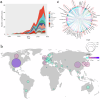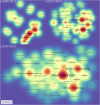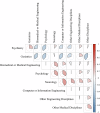Alzheimer's disease digital biomarkers multidimensional landscape and AI model scoping review
- PMID: 40523935
- PMCID: PMC12170881
- DOI: 10.1038/s41746-025-01640-z
Alzheimer's disease digital biomarkers multidimensional landscape and AI model scoping review
Abstract
As digital biomarkers gain traction in Alzheimer's disease (AD) diagnosis, understanding recent advancements is crucial. This review conducts a bibliometric analysis of 431 studies from five online databases: Web of Science, PubMed, Embase, IEEE Xplore, and CINAHL, and provides a scoping review of 86 artificial intelligence (AI) models. Research in this field is supported by 224 grants across 54 disciplines and 1403 institutions in 44 countries, with 2571 contributing researchers. Key focuses include motor activity, neurocognitive tests, eye tracking, and speech analysis. Classical machine learning models dominate AI research, though many lack performance reporting. Of 21 AD-focused models, the average AUC is 0.887, while 45 models for mild cognitive impairment show an average AUC of 0.821. Notably, only 2 studies incorporated external validation, and 3 studies performed model calibration. This review highlights the progress and challenges of integrating digital biomarkers into clinical practice.
© 2025. The Author(s).
Conflict of interest statement
Competing interests: The authors declare no competing interests.
Figures























Similar articles
-
Applications of Large Language Models in the Field of Suicide Prevention: Scoping Review.J Med Internet Res. 2025 Jan 23;27:e63126. doi: 10.2196/63126. J Med Internet Res. 2025. PMID: 39847414 Free PMC article.
-
Molecular feature-based classification of retroperitoneal liposarcoma: a prospective cohort study.Elife. 2025 May 23;14:RP100887. doi: 10.7554/eLife.100887. Elife. 2025. PMID: 40407808 Free PMC article.
-
Digital Biomarkers for Parkinson Disease: Bibliometric Analysis and a Scoping Review of Deep Learning for Freezing of Gait.J Med Internet Res. 2025 May 20;27:e71560. doi: 10.2196/71560. J Med Internet Res. 2025. PMID: 40392578 Free PMC article.
-
Altered cerebellar activation patterns in Alzheimer's disease: An activation likelihood estimation Meta-Analysis.Neuroimage Clin. 2025;46:103770. doi: 10.1016/j.nicl.2025.103770. Epub 2025 Mar 17. Neuroimage Clin. 2025. PMID: 40121822 Free PMC article.
-
Defining disease severity in atopic dermatitis and psoriasis for the application to biomarker research: an interdisciplinary perspective.Br J Dermatol. 2024 Jun 20;191(1):14-23. doi: 10.1093/bjd/ljae080. Br J Dermatol. 2024. PMID: 38419411 Free PMC article. Review.
Cited by
-
Organ-system-based subclassification of preeclampsia using machine learning predicts pregnancy outcomes.BMC Pregnancy Childbirth. 2025 Jul 24;25(1):787. doi: 10.1186/s12884-025-07892-7. BMC Pregnancy Childbirth. 2025. PMID: 40707898 Free PMC article.
References
-
- 2023 Alzheimer’s disease facts and figures. Alzheimer’s & dementia: J. Alzheimer’s Assoc.19, 1598-1695 (2023). - PubMed
Grants and funding
- LBY23H200002/Basic Public Welfare Research Project/Joint Fund Project of Zhejiang Province: Research on accurate localization of gait disorder brain region in Parkinson's disease based on pfMRI data set and hierarchical Bayesian model
- 2023ZF134/Zhejiang Province Traditional Chinese Medicine, Science, and Technology Project
- 2022KY1052/Zhejiang Provincial Medical and Health Science and Technology Program Project
- 2022-1133/First-Class Course of Zhejiang Province
LinkOut - more resources
Full Text Sources
Research Materials

